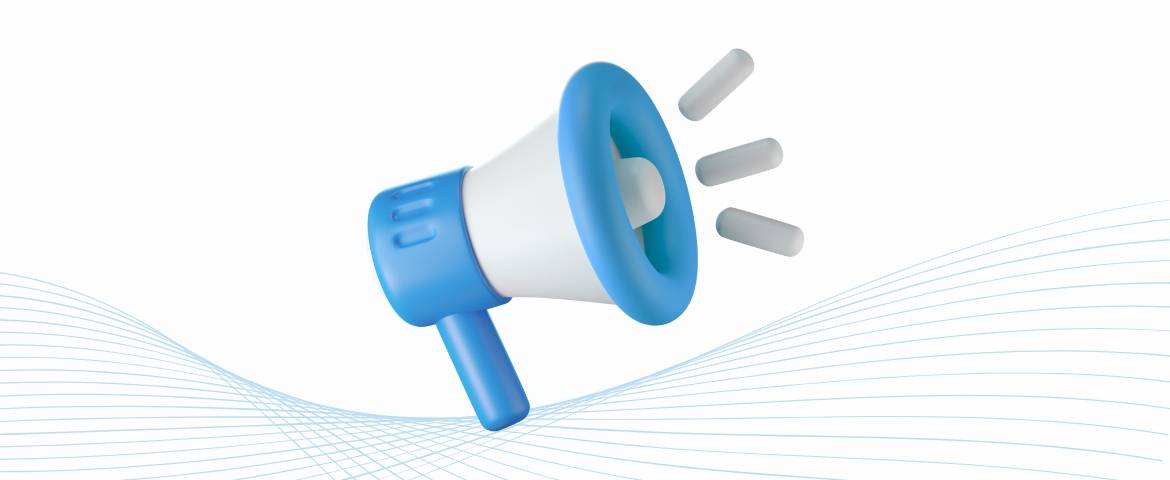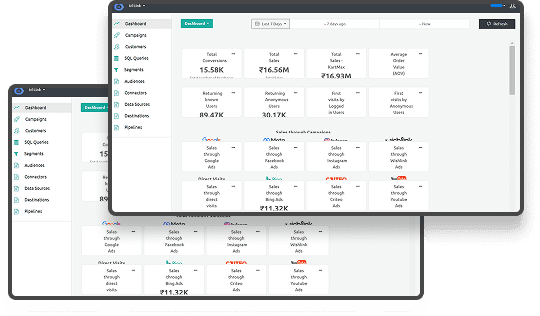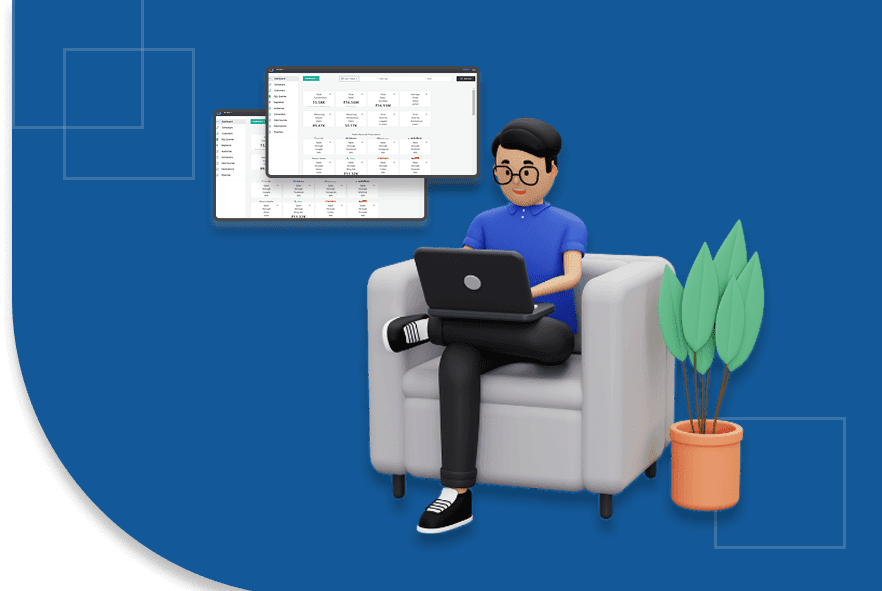Understanding Offline Advertising: Strategies and Effectiveness
Are you overlooking one of the most powerful marketing channels right under your nose?
While many campaigns stall under rising ad costs and shrinking third-party data, offline marketing continues to deliver reach and results, without privacy headaches. U.S. billboard and transit ads brought in nearly $10 billion last year, and out-of-home campaigns have grown consistently for over sixteen quarters. For teams struggling with fragmented targeting or unreliable attribution, this channel offers something simpler and more grounded.
TL;DR
- Offline marketing uses traditional methods like print, billboards, and events to build trust and connect with people.
- It works well with digital ads, reaching audiences who care about privacy.
- Offline ads are still effective, especially in privacy-focused areas, with more money being spent on them.
- Mixing offline and online ads helps brands reach more people, target better, and see better results.
What is Offline Marketing?
Offline marketing refers to promotional efforts that reach your audience without the use of digital channels. These strategies operate in the physical world and rely on traditional media to drive awareness, engagement, or conversions. It builds direct, tangible connections with your audience through personal interaction and sensory engagement.
Next up, let's look deeper into the various forms of offline marketing, each offering its own way to connect with your audience and deliver results.
Types of Offline Marketing
Offline marketing includes several established methods that let you connect with audiences beyond digital platforms. You can use them to boost awareness, complement online campaigns, or reach audiences in places where digital doesn't dominate. Each type offers a specific benefit depending on your goals and target audience.
Here are the most widely used types of offline marketing:
- Print Advertising: Use newspapers, magazines, and brochures to build trust and visibility, especially in industry-specific or local publications.
- Broadcast Advertising: TV and radio ads allow you to reach broad demographics with high-frequency messaging, perfect for brand-building at scale.
- Direct Mail: Send catalogs, postcards, and letters directly to your audience’s mailbox to drive response rates and improve personalization.
- Outdoor Advertising: Billboards, transit ads, and posters help you increase recall and stay top-of-mind through repeated exposure in high-traffic areas.
- Telemarketing: One-on-one phone outreach can qualify leads, gather customer feedback, and close sales in a highly personal setting.
- Event Sponsorships: Sponsor or participate in trade shows, industry expos, or community events to build credibility and face-to-face connections.
- Guerrilla Marketing: Execute unconventional campaigns in public spaces to grab attention, spark curiosity, and create memorable brand experiences.
- Branded Merchandise: Distribute branded items like pens, tote bags, or tech accessories to increase brand exposure and customer affinity.
These types often work best when integrated with digital strategies for better measurement and attribution. This leads us to the next topic, how offline marketing actually works behind the scenes.
How Does Offline Marketing Work?
Offline marketing works by using real-world touchpoints to connect with your audience in direct or indirect ways. It builds brand presence through channels your customers already interact with daily, on the street, in print, or at events.
Here are the most common ways offline marketing strategies function to build engagement and influence decision-making:
- You place print ads in magazines or newspapers to boost regional visibility and credibility.
- You distribute brochures or flyers at physical locations where your target audience is likely to visit.
- You run billboard or transit ads in areas with high foot or vehicle traffic for repeated exposure.
- You attend trade shows or sponsor industry events to create one-on-one engagement opportunities.
- You invest in direct mail campaigns that deliver personalized offers straight to your audience’s mailboxes.
- You provide branded merchandise at events to leave a tangible reminder of your brand.
- You collaborate with local radio or TV stations for a broader demographic reach in specific regions.
Offline marketing relies on strategic placement and repetition to ensure your brand stays top of mind. When paired with your digital efforts, it offers a well-rounded approach to customer engagement, especially in markets where privacy regulations make digital tracking more complex. Let’s now consider how offline marketing stands up in today’s market.
Also Read: Guide to Real-Time Analytics for Successful Campaign Optimization
Is Offline Marketing Effective Today?
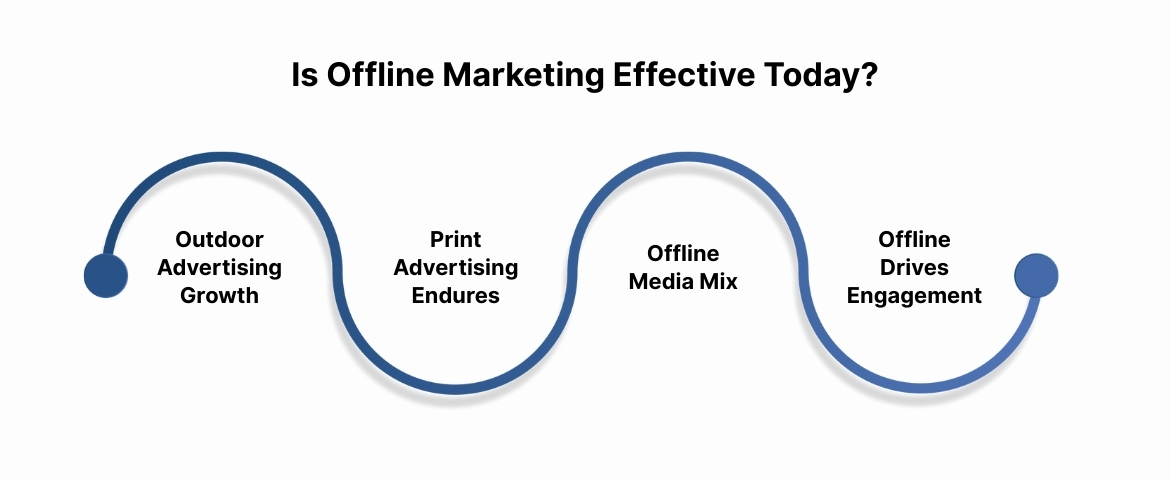
Offline marketing continues to deliver strong results in privacy-conscious, data-focused environments. You’ll find that traditional touchpoints still drive brand awareness and audience trust, even in digitally regulated markets.
A deeper look at current market data shows where offline marketing is working and why it still matters:
- Outdoor advertising is gaining traction: U.S. out-of-home ad revenue hit $2.78 billion in Q2, a 3.4% year-over-year increase. You can use outdoor placements to reinforce brand awareness without relying on cookies or device IDs, making them ideal for privacy-conscious audiences.
- Print advertising still holds firm: U.S. print ad revenue will reach $45.5 billion by 2025, with only a slight 3.1% decline. For you, this presents a steady, predictable medium for running location-based or segmented offers with lasting visibility.
- Offline remains part of the media mix: Global ad spending will top $1.08 trillion in 2025, with offline formats making up 26.8% of the spend. When you combine offline and online strategies, you build broader reach, better frequency, and higher channel attribution accuracy, especially useful when digital signals are fragmented.
- Offline drives scalable engagement: The global content marketing industry, including branded print and offline collateral, will be worth $600 billion. You can use this as a signal to invest in tactile brand touchpoints that deepen engagement and nurture leads over longer cycles.
What does this mean for you?
You can lean on offline channels like outdoor and print to tap into critical, privacy-sensitive markets. These updated figures show offline marketing isn’t outdated; it’s evolving. By integrating it with your analytics, you build privacy-compliant, omnichannel strategies that track ROI without over-relying on third-party data. It’s not about going offline, it’s about going full spectrum.
Now, let’s shift focus to some proven offline marketing strategies that can help your business tap into these opportunities.
Proven Offline Marketing Strategies
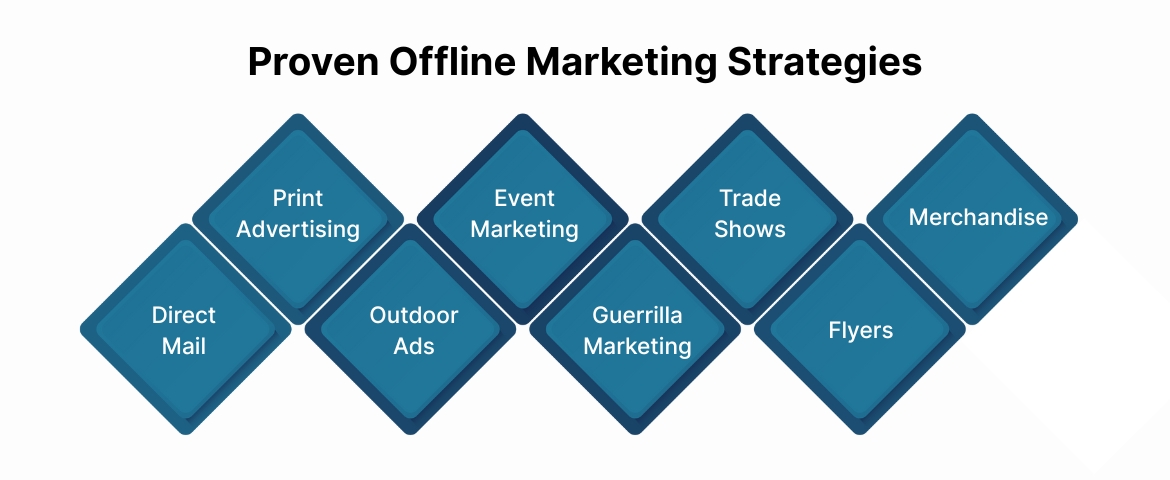
Offline marketing offers tangible, trust-building touchpoints that support your cookieless advertising solutions and multichannel brand strategies. You can use these approaches to reach segmented audiences, deepen brand recall, and create measurable moments in the real world.
Here’s how you can apply the most effective offline marketing strategies to support your broader marketing goals:
1. Direct Mail
Direct mail allows you to deliver personalized messages directly to your target’s physical mailbox. You can include promotional offers, product samples, or QR codes linking to custom landing pages. This is ideal when you need high visibility, longer engagement windows, and reliable ways to support first-party data collection.
2. Print Advertising
Print advertising builds credibility in niche or regional markets through placements in newspapers, industry magazines, or journals. You can promote product launches, exclusive campaigns, or brand narratives to a focused readership. Use this strategy when you want consistent visibility and alignment with audiences who value editorial environments and offline experiences.
3. Outdoor Ads
Outdoor advertising positions your brand in high-traffic physical locations like highways, subways, or retail zones. You gain repeated visibility and can reinforce awareness across demographics and footfall-heavy geographies. This format is most effective when you’re aiming for high recall in key urban centers with strict data privacy laws.
4. Event Marketing
Event marketing lets you engage directly with your audience through branded experiences, workshops, or sponsored panels. You gain one-on-one interactions that help shape trust and drive deeper brand loyalty. Choose this approach to support product education or community-building goals where digital noise often dilutes attention.
5. Guerrilla Marketing
Guerrilla marketing uses unconventional, surprise-driven tactics in public spaces to create buzz and emotional engagement. You can launch creative installations, flash events, or interactive street visuals that capture attention. This strategy works best when you're introducing new offerings or seeking viral amplification without heavy ad spend.
6.Trade Shows
Trade shows give you access to a targeted audience actively seeking partnerships, solutions, or innovations. You can showcase offerings, gather leads, and build authority through demos, talks, and booth interactions. Use this offline strategy to accelerate pipeline velocity while reinforcing brand trust in regulated industries.
7. Flyers
Flyers are cost-effective tools for spreading awareness in physical environments like retail stores, conferences, or transit hubs. You can promote offers, events, or sign-up incentives in a simple, trackable format. They’re especially useful when you want hyper-local impact without committing to long-term ad placements.
8. Merchandise
Branded merchandise helps your audience keep your company top-of-mind through everyday-use items like pens, notebooks, or tote bags. You can distribute them at events or through direct outreach. Use this tactic when aiming to drive lasting brand recall and emotional connection across your most engaged buyer segments.
However, as with any strategy, there are limitations to consider. Let's now examine when offline marketing might not be the right fit for your business.
Limitations and When It Might Not Be the Best Choice
Offline marketing serves specific goals well, but it may not fit every campaign type or business stage. It doesn’t offer real-time performance metrics, which can make optimization less immediate compared to digital. If your team relies heavily on conversion data or rapid testing cycles, this slower feedback may feel limiting, but not irrelevant.
It also involves higher upfront investment and longer lead times for execution. Revising a print ad or billboard isn’t as flexible as tweaking a digital asset. That said, when you align offline efforts with brand-building or awareness objectives, especially in targeted geographies, the returns can still complement digital strategies meaningfully.
If you're focused on online marketing and need real-time performance insights, Ingest Labs' server-side tracking and data intelligence tools are a better fit than offline channels.
Having discussed some challenges, let’s now see how offline compares to online marketing, and how combining the two could be the most effective approach.
Also Read: Navigating the Future: The Impact of a Cookieless World on Advertising
Offline vs. Online Marketing: Which One Works Better?
Both offline and online marketing serve distinct purposes in your customer acquisition strategy. You shouldn't view them as competing channels but as complementary forces that support your broader performance and privacy objectives.
Use the comparison below to evaluate how each channel fits your campaign goals, operational structure, and customer engagement model:
| Factor | Offline Marketing | Online Marketing |
|---|---|---|
| Measurement | Difficult to track in real time | Real-time performance tracking and analytics |
| Targeting Precision | Broad targeting by geography or demographics | Hyper-targeted by behavior, interest, or lookalike audiences |
| Personalization | Limited personalization through formats like direct mail | Deep personalization using customer data and segmentation |
| Cost Efficiency | Higher upfront investment (printing, media buying) | Variable cost, often more scalable for smaller budgets |
| Reach Speed | Slower to deploy and scale | Instant launch, easy A/B testing, and optimization |
| Privacy Compliance | Does not rely on third-party cookies | Increasingly complex under GDPR, CCPA, and cookie restrictions |
| User Engagement | Tangible, immersive engagement (events, merch) | Interactive, clickable formats, but easily ignored or blocked |
| Brand Trust | Perceived as more credible/trustworthy in some markets | May require social proof or reviews to build trust |
| Longevity | Longer shelf life (flyers, magazines, merchandise) | Shorter lifespan unless content is evergreen or retargeted |
As you weigh these factors, consider how integrating both offline and online marketing will help you craft a more effective strategy moving forward.
Strategic Takeaway for Marketing Teams
If you're operating in regulated environments or prioritizing first-party data, offline marketing complements your cookieless advertising solutions. It provides high-trust, tangible touchpoints when digital tracking becomes restrictive. However, online marketing offers speed, data-rich targeting, and measurable optimization.
It works better when you need agility, granular segmentation, or rapid experimentation at scale. Ultimately, your strongest marketing strategy blends both offline for brand-building and offline-first data acquisition, and online for retargeting, funnel progression, and performance tracking.
If you're starting or scaling your online marketing efforts, consider Ingest Labs to power accurate server-side tracking, first-party attribution, and real-time customer insights, all without relying on third-party cookies.
Final Thoughts
Striking the right balance between offline and online marketing is no longer optional—it’s essential to stay competitive. With growing privacy regulations and shifts in consumer behavior, you must adopt marketing strategies that are both data-driven and privacy-compliant. Combining traditional methods with digital precision ensures you connect meaningfully with customers while meeting performance goals. This discussion underscores the value of integrated approaches in a post-cookie era.
To support this shift, Ingest Labs offers purpose-built solutions tailored to your operational needs. With Ingest IQ, you gain server-side tracking and enhanced conversions without compromising compliance. Ingest ID empowers accurate attribution and customer data unification, while Event IQ helps manage consent, reduce cart abandonment, and power cross-channel insights. Whether you're scaling campaigns or safeguarding user privacy, Ingest Labs gives you the tools to market smarter, ethically, and with clarity.
Ready to future-proof your campaigns? Book a demo now and explore how our cookieless advertising solutions can drive secure, data-informed growth.
FAQ
1. What’s the key difference between offline and online marketing?
Offline marketing uses traditional channels like print or events, while online marketing relies on digital platforms and allows real-time tracking and targeting.
2. Can offline and online marketing work together?
Yes, combining both creates a more complete strategy, offline builds trust and presence, while online provides agility and data-driven optimization.
3. Is online marketing more cost-effective than offline?
Generally, online marketing offers more scalable options with lower upfront costs, especially for testing and targeting specific audiences.
4. How does privacy regulation impact digital marketing?
Regulations like GDPR and CCPA restrict how user data is collected and used, requiring businesses to adopt compliant, consent-based strategies.
5. Why is real-time tracking important in digital campaigns?
It helps marketers adjust strategies on the fly, identify what’s working, and improve performance without waiting for post-campaign reports.



